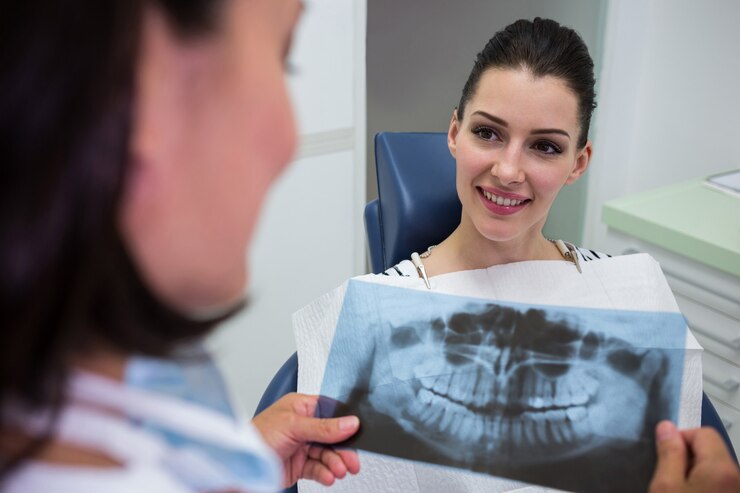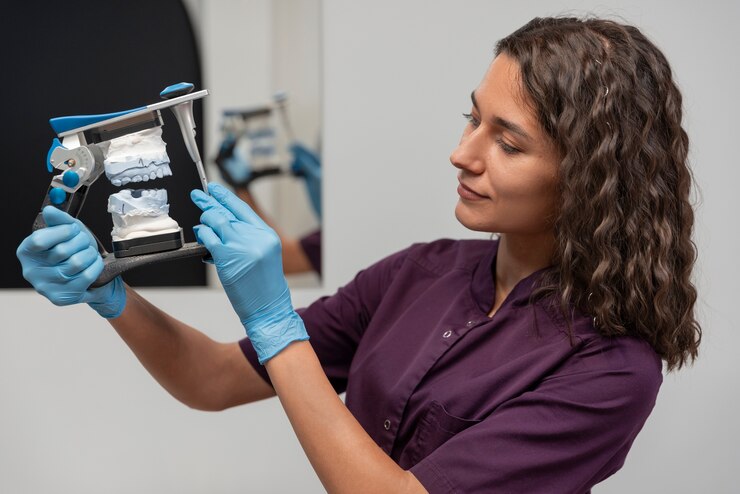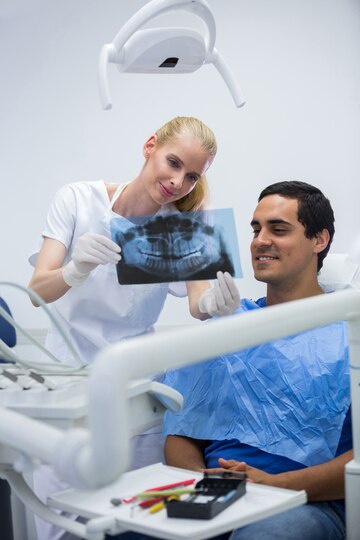Understanding Full Mouth Restoration
Assessing the Need for Comprehensive Dental Work
Recognizing when to seek full mouth restoration is crucial for maintaining not only oral health but also overall well-being. Bleeding gums, broken teeth, and persistent toothache are signs that should not be ignored. These symptoms can indicate underlying issues that require comprehensive dental work.
A full mouth restoration in Ottawa journey begins at The Dental Health Practice on Merivale with a thorough assessment of your dental health. This evaluation will determine the extent of damage and the necessary treatments to restore function and aesthetics.
Here's a list of common dental concerns that might necessitate a full mouth restoration:
- Bleeding gums
- Broken teeth
- Mouth ulcers
- Replacing silver fillings
- Toothache
- Wisdom teeth
Each concern is addressed with a variety of treatments tailored to the individual's needs, ranging from general dentistry to more specialized procedures like implants for single or multiple teeth. Understanding your dental concerns is the first step towards a renewed smile and improved quality of life at Nepean Family Dental.
Exploring Options: Crowns, Bridges, and Dentures
When considering full mouth restoration, it's essential to understand the variety of options available. Crowns are custom-fitted caps that cover the entire tooth, restoring its shape, size, and strength. Bridges fill the gap created by one or more missing teeth, anchored on either side by crowns. Dentures, which can be partial or complete, replace missing teeth and are removable for cleaning.
- Crowns: Restore individual teeth
- Bridges: Replace one or more missing teeth
- Dentures: Offer a removable solution for tooth loss
Each option serves a unique purpose and can be tailored to meet the specific needs and preferences of the patient. The choice between these solutions will depend on factors such as the extent of tooth loss, the health of remaining teeth, and personal comfort.
Selecting the right treatment is a collaborative process between the patient and the dental team. It involves careful consideration of the patient's oral health history, aesthetic goals, and budget. For instance, while dental implants offer a more permanent solution, they may not be suitable for everyone due to health or financial constraints.
The Role of Orthodontics in Full Mouth Rehabilitation
Orthodontics plays a pivotal role in full mouth restoration, not only improving the aesthetic alignment of teeth but also ensuring proper bite function. Orthodontic treatments can be the foundation for further restorative work, creating the ideal conditions for crowns, bridges, and implants.
Orthodontic intervention often precedes other dental procedures to optimize the oral structure, which can significantly enhance the outcome of a full mouth restoration.
The following list outlines common orthodontic options in full mouth rehabilitation:
- Invisalign: A discreet way to straighten teeth using clear aligners.
- Fixed braces: Traditional method for correcting teeth alignment.
- Lingual braces: Braces that are placed behind the teeth for a less visible option.
- Clear aligners: Similar to Invisalign, these aligners are custom-made and removable.
Each option has its own set of indications, and the choice largely depends on the patient's specific dental issues and personal preferences. A thorough assessment by a dental professional is crucial to determine the most suitable orthodontic treatment within a full mouth restoration plan.
Innovations in Smile Makeover: From SmileFast to Veneers
The evolution of dental technology has ushered in a new era of smile makeovers, offering a range of options to suit individual needs and preferences. SmileFast is one such innovation, streamlining the process of cosmetic dentistry and providing rapid results. Alongside, veneers remain a popular choice for their ability to transform smiles with a natural and durable finish.
- SmileFast: A quick and minimally invasive approach to cosmetic enhancement.
- Veneers: Custom-made shells that cover imperfections and enhance the smile's appearance.
Embracing these advancements not only improves aesthetics but also boosts confidence and overall satisfaction with one's smile. The choice between SmileFast and veneers depends on the patient's specific condition, desired outcome, and budget.
Each option comes with its own set of considerations, from the longevity and maintenance of veneers to the speed and convenience of SmileFast. Consulting with a dental professional is crucial to determine the best path to a radiant smile.
Advanced Dental Procedures for Restoration

The Journey of Dental Implants: Single Tooth to Full Arch
Embarking on the journey of dental implants can be a transformative experience for individuals seeking to restore their smile. Dental implants offer a permanent solution for missing teeth, ranging from a single tooth to a full arch restoration. The process begins with a personalized treatment plan, tailored to address each patient's unique dental needs and aesthetic goals.
- Initial Consultation: Assessing oral health and implant needs.
- Treatment Planning: Crafting a customized strategy.
- Surgical Procedure: Placing the implant post in the jawbone.
- Healing Period: Allowing time for osseointegration.
- Final Restoration: Attaching the crown or denture.
The success of dental implants lies in their ability to integrate with the bone, providing a stable foundation for the new teeth. This not only improves the function but also preserves the facial structure.
Patients can expect a detailed breakdown of costs and benefits during the initial consultation, ensuring clarity and confidence in their investment. The table below illustrates a simplified cost comparison between different implant options:
|
Implant Type |
Average Cost (USD) |
|
Single Tooth Implant |
$3,000 - $4,500 |
|
Multiple Teeth Implants |
$6,000 - $10,000 |
|
Full Arch with Implants |
$20,000 - $30,000 |
It's important to note that these prices are averages and can vary based on individual circumstances and geographic location. Dental implants are a significant investment in one's oral health, but the long-term benefits often outweigh the initial cost.
Endodontics and Periodontics: Beyond Basic Care
When it comes to full mouth restoration, endodontics and periodontics represent specialized fields that address the deeper issues affecting oral health. Endodontic treatments focus on the interior health of teeth, particularly root canal therapy, which removes infected pulp and seals the tooth to prevent further damage. Periodontics, on the other hand, deals with the structures supporting the teeth, primarily targeting gum disease.
Both endodontics and periodontics are essential for restoring not just the appearance, but also the functionality and health of your mouth. These treatments go beyond basic care, tackling problems that can lead to tooth loss and systemic health issues if left untreated.
Here's a quick overview of common dental concerns and the corresponding treatments:
- Dental Concerns
- Bleeding gums
- Broken teeth
- Mouth ulcers
- Replacing silver fillings
- Toothache
- Wisdom teeth
- Treatments
- General dentistry (e.g., routine dental health reviews)
- Dental hygiene (e.g., gum disease therapy)
- Nervous patients (e.g., dental sedation)
- Emergency dental care
- Implants (from single tooth to multiple teeth)
Advanced procedures in these specialties are often the cornerstone of a successful full mouth restoration, ensuring that every aspect of oral health is addressed.
Navigating Complex Cases: TMJ Disorder and Snoring Solutions
Full mouth restoration often involves addressing not just the aesthetics and functionality of teeth, but also complex dental and medical conditions. TMJ disorders and snoring are two such conditions that can significantly impact one's quality of life.
For those suffering from TMJ disorders, symptoms can range from jaw pain and headaches to difficulty chewing and even lockjaw. Treatment options vary based on the severity of the condition, but may include:
- Custom-fitted oral appliances to alleviate stress on the jaw
- Physical therapy exercises to strengthen jaw muscles
- Modifications to dental restorations to improve bite alignment
Snoring solutions, on the other hand, often involve the use of anti-snoring devices. These devices are designed to keep the airway open during sleep, which can also benefit those with sleep apnea. Options include:
- Mandibular advancement devices (MADs) that reposition the lower jaw forward
- Tongue stabilizing devices (TSDs) that hold the tongue in place
It's essential to consult with a dental professional who can provide a comprehensive evaluation and tailor a treatment plan to your specific needs. Early intervention can prevent further complications and improve overall health.
Cosmetic Enhancements and Smile Perfection

Teeth Whitening: The Path to a Brighter Smile
Professional teeth whitening is more than just a cosmetic enhancement; it's a transformative experience that can boost your confidence and improve your overall appearance. The immediate benefits of in-office whitening are undeniable, offering a quick and effective solution to discoloration caused by various factors such as diet, age, and certain habits.
Professional treatments are tailored to individual needs, ensuring that each patient achieves the optimal shade of brightness while maintaining the health of their teeth.
Maintaining that radiant smile at home is crucial. Here are some practical tips:
- Avoid foods and beverages that stain teeth, like coffee, red wine, and berries.
- Practice good oral hygiene by brushing twice a day and flossing regularly.
- Consider using a whitening toothpaste or mouthwash as part of your daily routine.
- Regular dental check-ups and cleanings are essential to remove surface stains and plaque.
Patients like Karen Shaw have experienced remarkable results, often achieving several shades lighter than expected. While some sensitivity during the process is common, the outcome is a brighter, more confident smile.
Composite Bonding and Veneers: Crafting the Ideal Smile
Composite bonding and veneers are two of the most popular cosmetic dental procedures for achieving an ideal smile. Composite bonding is a versatile treatment that can correct chips, gaps, and stains in teeth. It involves the application of a tooth-colored resin that is shaped and polished to match the surrounding teeth, offering a natural and improved appearance.
Veneers, on the other hand, are thin shells of porcelain or composite material that are custom-made to fit over the front surface of teeth. They provide a more dramatic transformation, perfect for those looking to change the shape, size, or color of their teeth. Here's a quick comparison:
|
Treatment |
Purpose |
Material |
Durability |
|
Composite Bonding |
Correct minor imperfections |
Resin |
5-7 years |
|
Veneers |
Comprehensive smile makeover |
Porcelain/Composite |
10-15 years |
Both treatments require minimal tooth preparation, which means more of your natural tooth structure is preserved. This is a key benefit for maintaining long-term dental health.
Choosing between composite bonding and veneers depends on the individual's needs, the extent of the dental issues, and the desired outcome. It's essential to consult with a dental professional to determine the best option for your smile.
The Impact of Straightening: Invisalign and Clear Aligners
Achieving a perfectly aligned smile is no longer associated with the discomfort and visibility of traditional braces. Invisalign and clear aligners offer a discreet and convenient solution for straightening teeth, tailored to fit the modern lifestyle.
- Invisalign is a custom-made series of aligners created just for you, designed to be virtually invisible and fit snugly over your teeth.
- Clear aligners work in a similar fashion, with the added benefit of being removable, allowing for easier eating and oral hygiene.
The clear aligner technology not only straightens teeth but also corrects bite issues, contributing to improved oral health and functionality.
Patients often report a significant boost in self-esteem as their smile transforms. The process is simple: after a dental consultation, a custom treatment plan is developed. Aligners are then worn for a prescribed amount of time each day, gradually moving teeth into the desired position. Regular check-ins with your dentist ensure progress is on track.
|
Treatment Stage |
Duration |
Aligner Change Frequency |
|
Initial Phase |
1-2 weeks |
Every 1-2 weeks |
|
Mid Treatment |
2-6 months |
Every 2-3 weeks |
|
Final Phase |
6+ months |
As needed |
It's important to note that while Invisalign and clear aligners are suitable for many, they may not be the best option for everyone. Complex dental issues may require alternative orthodontic treatments.
The Patient Experience at Petersen Family Dentistry
Personalized Preventive Plans for Long-Term Oral Health
At Petersen Family Dentistry, we understand that prevention is better than cure. Our personalized preventive plans are designed to maintain your oral health and prevent future dental issues. Regular dental checkups are a cornerstone of these plans, as they allow for early detection and treatment of potential problems.
- Professional dental cleanings every six months
- Annual X-rays and dental exams
- Personalized oral hygiene advice
Embracing a proactive approach to dental care not only ensures a healthier smile but also contributes to your overall well-being. Our preventive plans are tailored to each individual's needs, ensuring that you receive the most effective care possible.
Investing in regular dental checkups and cleanings is not just about maintaining a radiant smile; it's about taking charge of your health. With advancements in dental technology, such as 3D imaging and pain-free laser treatments, the patient experience has never been more comfortable or efficient. Remember, by prioritizing preventive care, you're also making a wise financial decision, as most dental insurance plans fully cover the costs of standard preventative services.
Dental Sedation and Emergency Care: Ensuring Comfort and Safety
At Petersen Family Dentistry, we understand that dental emergencies can be stressful and often painful experiences. Your comfort and safety are our top priorities during these critical times. Our team is equipped to provide immediate and effective care, ensuring that your dental emergency is addressed with precision and compassion.
In the event of a dental emergency, our dentists are prepared to offer the latest treatments and pain management techniques. We aim to not only resolve the immediate issue but also to guide you towards long-term oral health.
When faced with a dental emergency, it's crucial to know what to expect and how to proceed:
- Ask about treatment options and understand the potential risks or side effects.
- Inquire about follow-up care and the necessary steps to ensure a full recovery.
- Discuss costs and payment options, including how they align with your insurance.
- Seek advice on preventing future emergencies and maintaining oral health.
Our commitment extends beyond the emergency room. We provide personalized care and detailed explanations to help you navigate through these challenging situations. With Petersen Family Dentistry, you're not just a case number; you're a valued individual whose well-being is our foremost concern.
Patient Stories: Transformations That Inspire Confidence
At Petersen Family Dentistry, we believe that every patient's journey is a testament to the transformative power of compassionate dental care. Our patients' stories are not just about dental restoration, but about regaining self-esteem and joy in life.
- Teresa Freeman's experience highlights the profound impact of a supportive dental team. After years of dental anxiety, she now boasts a smile she's proud of, thanks to the patience and understanding of our staff.
- Another patient, who once couldn't even sit in the dental chair, overcame their fears and now looks forward to dental visits as an opportunity to connect with our caring team.
These narratives underscore the importance of a dental practice that prioritizes not only the technical aspects of care but also the emotional well-being of its patients.
Our commitment to patient satisfaction is reflected in the feedback we receive. With over 1.7 million happy patients, the stories of individuals like Alexis P., who found comfort and solace in our care, serve as a beacon for our dedication to excellence.
Financial and Educational Aspects of Dental Care

Investing in Your Smile: Understanding the Costs and Benefits
Investing in your dental health is not just about aesthetics; it's about overall well-being. Regular preventive care, such as cleanings and exams, can save you from costly procedures in the future. Dental insurance often covers these routine visits, making it easier to maintain your oral health.
- Dental insurance plans typically cover twice-yearly cleanings and annual X-rays.
- Catching dental issues early can prevent more extensive and expensive treatments.
- Membership plans may offer additional savings and benefits.
Investing in preventive dental care is a wise financial decision that can lead to long-term health benefits and cost savings.
Understanding the financial aspect of dental care is crucial. Here's a quick overview of potential costs and savings:
|
Procedure |
Without Insurance |
With Insurance |
|
Cleaning |
$100 - $200 |
$0 |
|
X-rays |
$50 - $150 |
$0 |
|
Filling |
$150 - $300 |
$20 - $100 |
Remember, these figures are estimates and can vary based on location and specific dental practices. It's important to consult with your dentist and insurance provider to understand your coverage and out-of-pocket costs.
Diet and Oral Care Habits: Tips for a Tooth-Friendly Lifestyle
Maintaining a tooth-friendly diet is essential for oral health. Eat a balanced diet rich in fruits and vegetables, and limit sugary and acidic foods that can promote bacteria growth leading to cavities and gum disease. Hydration is also key; drinking water helps rinse away food particles and bacteria.
Regular brushing and flossing are the bedrock of oral hygiene. Brush at least twice a day with fluoride toothpaste and floss daily to remove plaque from areas your toothbrush can't reach.
In addition to diet and hygiene, it's important to protect your teeth during physical activities and avoid using them as tools. Here are some practical tips:
- Brush twice a day and floss once a day.
- Wear a mouthguard during sports.
- Avoid biting hard objects like ice or popcorn kernels.
- Use tools, not teeth, for cutting or opening items.
- Follow care instructions if you have braces.
Remember, regular dental checkups and cleanings are crucial for maintaining oral health and catching potential issues early.
The Importance of Education in Preventive Oral Health
Education plays a pivotal role in maintaining a healthy smile and overall well-being. Understanding the connection between oral health and systemic health is crucial for adopting a proactive approach to dental care. By being informed, individuals are more likely to engage in preventive measures that ensure long-term oral health and avoid costly interventions.
A well-informed patient is an empowered patient. Knowledge about proper oral hygiene practices and the risks associated with poor dental habits can lead to better health outcomes and a more confident smile.
Here are some effective tips to prevent tooth decay and gum disease:
- Brush and floss regularly to remove plaque and food particles.
- Limit intake of sugary and acidic foods and beverages to protect enamel.
- Use fluoride toothpaste to strengthen teeth and prevent cavities.
- Schedule regular dental checkups and cleanings for professional care.
By integrating these practices into daily routines, individuals can significantly reduce the risk of dental problems and enhance their quality of life.
Conclusion
Embarking on the journey of full mouth restoration can be a transformative experience, not just for your smile, but for your overall quality of life. Throughout this comprehensive guide, we've explored a myriad of options available to you, from dental implants to orthodontics, and the incredible impact they can have. Whether you're considering crowns, bridges, dentures, or a complete smile makeover, the key is to find a personalized plan that suits your needs. Remember, the expertise and care provided by Petersen Family Dentistry in Broomfield, Colorado, can be your ally in this process. With the right approach and a commitment to oral health, you can master your smile again and enjoy the confidence that comes with it.


No comments yet